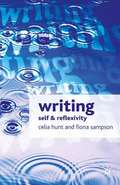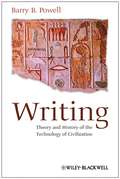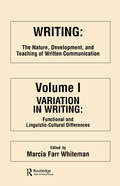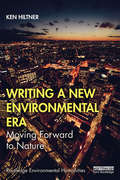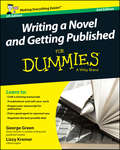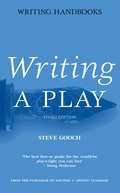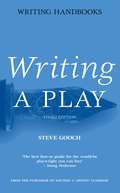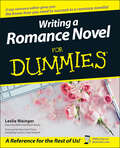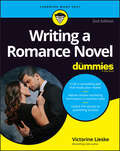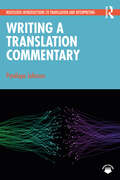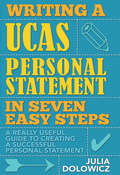- Table View
- List View
Writing: A practical guide to planning, starting and finishing a novel
by David HewsonYou are a writer and you have a killer book idea. When your project starts to take off you will find yourself managing a writhing tangle of ideas, possibilities and potential potholes. How do you turn your inspiration into a finished novel? Writing a User's Manual offers practical insight into the processes that go into writing a novel, from planning to story development, research to revision and, finally, delivery in a form which will catch the eye of an agent or publisher.David Hewson, a highly productive and successful writer of popular fiction with more than sixteen novels in print in twenty or so languages, shows how to manage the day to day process of writing.Writers will learn how to get the best out of software and novel writing packages such as Scrivener, which help you view your novel not as one piece of text, but as individual linked scenes, each with their own statistics, notes and place within the novel structure. As you write, you will need to assemble the main building blocks to underpin your artistry : story structure; genre - and how that affects what you write; point of view; past, present or future tense; software for keeping a book journal to manage your ideas, research and outlining; organization and more.The advice contained in this book could mean the difference between finishing your novel, and a never-ending work in progress. An essential tool for writers of all kinds. Foreword by Lee Child.
Writing: Self And Reflexivity (PDF)
by Celia Hunt Fiona SampsonThis guide is ideal for students of creative writing who wish to explore the writing process and its relationship to self in order to develop as writers. Each chapter links a range of theoretical approaches to one practical aspect of writing, using illustrations from fiction, poetry and literary non-fiction, and suggesting practical exercises for pursuing the topic further. The book will enable students to develop literary, critical and psychodynamic understandings of the creative process and to explore a range of key topics.
Writing: Texts, Processes and Practices (Applied Linguistics and Language Study)
by Ken Hyland Christopher N. CandlinWriting: Texts, Processes and Practices offers an innovative and multidisciplinary approach to writing in a variety of academic and professional settings. The book is composed of a series of original research-based accounts by leading authorities from a range of disciplines. The papers are linked through a unifying perspective which emphasises the role of cultural and institutional practices in the construction and interpretation of written texts.This important new book integrates different approaches to text analysis, different perspectives on writing processes, and the different methodologies used to research written texts. Throughout,an explicit link is made between research and practice illustrated with reference to a number of case studies drawn from professional and classroom contexts.The book will be of considerable interest to those concerned with professional or academic writing and will be of particular value to students and lecturers in applied linguistics, communication studies, discourse analysis, and professional communications training.The contributors to this volume are: Robert J. BarrettVijay K. BhatiaChristopher N. CandlinYu-Ying ChangSandra GollinKen HylandRoz IvanicMary R. LeaIan G. MalcolmJohn MiltonGreg MyersGuenter A. PlumBrian StreetJohn M. SwalesSue WeldonPatricia Wright
Writing: Texts, Processes and Practices (Applied Linguistics and Language Study)
by Ken Hyland Christopher N. CandlinWriting: Texts, Processes and Practices offers an innovative and multidisciplinary approach to writing in a variety of academic and professional settings. The book is composed of a series of original research-based accounts by leading authorities from a range of disciplines. The papers are linked through a unifying perspective which emphasises the role of cultural and institutional practices in the construction and interpretation of written texts.This important new book integrates different approaches to text analysis, different perspectives on writing processes, and the different methodologies used to research written texts. Throughout,an explicit link is made between research and practice illustrated with reference to a number of case studies drawn from professional and classroom contexts.The book will be of considerable interest to those concerned with professional or academic writing and will be of particular value to students and lecturers in applied linguistics, communication studies, discourse analysis, and professional communications training.The contributors to this volume are: Robert J. BarrettVijay K. BhatiaChristopher N. CandlinYu-Ying ChangSandra GollinKen HylandRoz IvanicMary R. LeaIan G. MalcolmJohn MiltonGreg MyersGuenter A. PlumBrian StreetJohn M. SwalesSue WeldonPatricia Wright
Writing: Theory and History of the Technology of Civilization
by Barry B. PowellWriting: Theory and History of the Technology of Civilization traces the origins of writing tied to speech from ancient Sumer through the Greek alphabet and beyond. Examines the earliest evidence for writing in Mesopotamia in the fourth millennium BC, the origins of purely phonographic systems, and the mystery of alphabetic writing Includes discussions of Ancient Egyptian,Chinese, and Mayan writing Shows how the structures of writing served and do serve social needs and in turn create patterns of social behavior Clarifies the argument with many illustrations
Writing: Theory and History of the Technology of Civilization
by Barry B. PowellWriting: Theory and History of the Technology of Civilization traces the origins of writing tied to speech from ancient Sumer through the Greek alphabet and beyond. Examines the earliest evidence for writing in Mesopotamia in the fourth millennium BC, the origins of purely phonographic systems, and the mystery of alphabetic writing Includes discussions of Ancient Egyptian,Chinese, and Mayan writing Shows how the structures of writing served and do serve social needs and in turn create patterns of social behavior Clarifies the argument with many illustrations
Writing: Self and Reflexivity
by Fiona Sampson Celia HuntExploring the writing process and its relationship to self, this guide synthesizes critical and creative theories of writing for both writers and readers. Each chapter links a range of theoretical approaches to one practical aspect of writing, using illustrations from fiction, poetry and literary non-fiction, and suggesting practical exercises for pursuing the topic further. The book will enable students to develop literary, critical and psychodynamic understandings of the creative process and to explore a range of key topics.
Writing: The Nature, Development, and Teaching of Written Communication
by M. Farr WhitemanFirst Published in 1982. Routledge is an imprint of Taylor & Francis, an informa company.
Writing: The Nature, Development, and Teaching of Written Communication
by M. Farr WhitemanFirst Published in 1982. Routledge is an imprint of Taylor & Francis, an informa company.
Writing a First Novel: Reflections on the Journey
by Karen StevensIn this inspiring collection of essays, a range of award-winning, established and newly published writers offer highly personal accounts of their creative processes. Authors reveal the anxieties, considerations and discoveries that shaped their own first novels, arming new writers with practical advice, focus and inspiration. The book's final section presents the perspectives of an agent, a publisher and an author on the business of publishing a first novel. Writing a First Novel offers an illuminating read for both aspiring and seasoned writers. It contains contributions by: - Hanif Kureishi - Valerie Martin - Johanna Skibsrud - David Vann - Maile Chapman - Edward Hogan - Kishwar Desai - Wena Poon - Alison MacLeod - Andrew Cowan - Jane Rusbridge - Isabel Ashdown - Helon Habila - David Swann - Soumya Bhattacharya - Jane Feaver - Hannah Westland - Helen Garnons-Williams - Lionel Shriver
Writing a New Environmental Era: Moving forward to nature (Routledge Environmental Humanities)
by Ken HiltnerWriting a New Environmental Era first considers and then rejects back-to-nature thinking and its proponents like Henry David Thoreau, arguing that human beings have never lived at peace with nature. Consequently, we need to stop thinking about going back to what never was and instead work at moving forward to forge a more harmonious relationship with nature in the future. Using the rise of the automobile and climate change denial literature to explore how our current environmental era was written into existence, Ken Hiltner argues that the humanities—and not, as might be expected, the sciences—need to lead us there. In one sense, climate change is caused by a rise in atmospheric CO2 and other so-called greenhouse gases. Science can address this cause. However, approached in another way altogether, climate change is caused by a range of troubling human activities that require the release of these gases, such as our obsessions with cars, lavish houses, air travel and endless consumer goods. The natural sciences may be able to tell us how these activities are changing our climate, but not why we are engaging in them. That’s a job for the humanities and social sciences. As this book argues, we need to see anthropogenic (i.e. human-caused) climate change for what it is and address it as such: a human problem brought about by human actions. A passionate and personal exploration of why the Environmental Humanities matter and why we should be looking forward, not back to nature, this book will be essential reading for all those interested in the future and sustainability of our planet.
Writing a New Environmental Era: Moving forward to nature (Routledge Environmental Humanities)
by Ken HiltnerWriting a New Environmental Era first considers and then rejects back-to-nature thinking and its proponents like Henry David Thoreau, arguing that human beings have never lived at peace with nature. Consequently, we need to stop thinking about going back to what never was and instead work at moving forward to forge a more harmonious relationship with nature in the future. Using the rise of the automobile and climate change denial literature to explore how our current environmental era was written into existence, Ken Hiltner argues that the humanities—and not, as might be expected, the sciences—need to lead us there. In one sense, climate change is caused by a rise in atmospheric CO2 and other so-called greenhouse gases. Science can address this cause. However, approached in another way altogether, climate change is caused by a range of troubling human activities that require the release of these gases, such as our obsessions with cars, lavish houses, air travel and endless consumer goods. The natural sciences may be able to tell us how these activities are changing our climate, but not why we are engaging in them. That’s a job for the humanities and social sciences. As this book argues, we need to see anthropogenic (i.e. human-caused) climate change for what it is and address it as such: a human problem brought about by human actions. A passionate and personal exploration of why the Environmental Humanities matter and why we should be looking forward, not back to nature, this book will be essential reading for all those interested in the future and sustainability of our planet.
Writing a New France, 1604-1632: Empire and Early Modern French Identity (Transculturalisms, 1400-1700)
by Brian BrazeauThe focus of this study is the exciting period of French overseas exploration directly following the stagnation caused by the Wars of Religion. The book examines the early period of French involvement in Northeastern America through readings of key texts, principally travel and missionary accounts. Among the works examined are travel writings by Marc Lescarbot (Histoire de la Nouvelle-France) and Samuel de Champlain (Voyages), and missionary works by Gabriel Sagard (Dictionnaire de la Langue Huronne, Histoire du Canada), Jean de Brébeuf, and Paul le Jeune (early Relations de Jésuites). Through a careful examination of these texts, the author discerns a French "rewriting of the self" in relation to the American other, represented by both land and people. America, Brazeau argues, allowed a consolidation of past markers of identity, and forced a radical rereading of others, due to the difficulties presented by the Canadian wilderness and its natives. Writing a New France, 1604-1632 sheds fresh light on a significant moment in French colonial history while providing an innovative contribution to the understanding of early modern French identity and cultural contact.
Writing a New France, 1604-1632: Empire and Early Modern French Identity (Transculturalisms, 1400-1700)
by Brian BrazeauThe focus of this study is the exciting period of French overseas exploration directly following the stagnation caused by the Wars of Religion. The book examines the early period of French involvement in Northeastern America through readings of key texts, principally travel and missionary accounts. Among the works examined are travel writings by Marc Lescarbot (Histoire de la Nouvelle-France) and Samuel de Champlain (Voyages), and missionary works by Gabriel Sagard (Dictionnaire de la Langue Huronne, Histoire du Canada), Jean de Brébeuf, and Paul le Jeune (early Relations de Jésuites). Through a careful examination of these texts, the author discerns a French "rewriting of the self" in relation to the American other, represented by both land and people. America, Brazeau argues, allowed a consolidation of past markers of identity, and forced a radical rereading of others, due to the difficulties presented by the Canadian wilderness and its natives. Writing a New France, 1604-1632 sheds fresh light on a significant moment in French colonial history while providing an innovative contribution to the understanding of early modern French identity and cultural contact.
Writing a Novel: Bring Your Ideas To Life The Faber Academy Way
by Richard SkinnerWriting A Novel is not a set of rules and regulations. It is an atlas, a guide to finding your own way over the treacherous passes of your first novel. Pulling together his years of experience as a novelist and a teacher, Richard Skinner covers the basics of writing great fiction - narrators, characters, settings - with charm and rigour. But more than that, he argues that the journey towards a final manuscript is as important as the finished article itself.His approach works: many of Richard's students have gone on to secure publishing deals and many more have left his courses with work to be proud of. With its balance of warmth and wisdom, Writing a Novel will give any aspiring writer the confidence to face the blank page -- and to fill it.
Writing a Novel and Getting Published For Dummies UK
by George Green Lizzy E. KremerLearn to: Craft a winning manuscript Troubleshoot and edit your work Prepare your manuscript for publication Find a good agent to represent you Negotiate the best possible deal Turn your aspiration into reality with this completely updated guide If you’ve always wanted to write that great novel, but never knew where to start, look no further! With a published author advising you on how to write well and a literary agent providing insight into getting a publishing deal, this updated guide gives you the inside track on the art and science of breaking into the fiction-publishing industry. Taking you step by step from concept to contract, this book provides the tools you need to tell your story with skill and approach agents and publishers with confidence. Dive in — check out how to combine your natural talent with the writing techniques used by successful authors Establish a firm foundation — construct your basic story, plot and structure Examine the key elements — create characters, develop dialogue, explore relationships and insert conflict Fine-tune and finish up — discover tips on adding detail, creativity and flair while bringing your work to a close Get published — take the next step by weighing up your publishing options, working with agents and negotiating deals Find out more — check out additional advice, like the most common mistakes you need to avoid, and tips from published authors Open the book and find: Tips for getting started Creative ways to develop plots, storylines, characters and dialogue The seven basic stories and how to put them to work Tricks for crafting a great ending to your novel How to prepare your manuscript for editing and publishing The lowdown on the business side of publishing
Writing a Novel and Getting Published For Dummies UK
by George Green Lizzy E. KremerLearn to: Craft a winning manuscript Troubleshoot and edit your work Prepare your manuscript for publication Find a good agent to represent you Negotiate the best possible deal Turn your aspiration into reality with this completely updated guide If you’ve always wanted to write that great novel, but never knew where to start, look no further! With a published author advising you on how to write well and a literary agent providing insight into getting a publishing deal, this updated guide gives you the inside track on the art and science of breaking into the fiction-publishing industry. Taking you step by step from concept to contract, this book provides the tools you need to tell your story with skill and approach agents and publishers with confidence. Dive in — check out how to combine your natural talent with the writing techniques used by successful authors Establish a firm foundation — construct your basic story, plot and structure Examine the key elements — create characters, develop dialogue, explore relationships and insert conflict Fine-tune and finish up — discover tips on adding detail, creativity and flair while bringing your work to a close Get published — take the next step by weighing up your publishing options, working with agents and negotiating deals Find out more — check out additional advice, like the most common mistakes you need to avoid, and tips from published authors Open the book and find: Tips for getting started Creative ways to develop plots, storylines, characters and dialogue The seven basic stories and how to put them to work Tricks for crafting a great ending to your novel How to prepare your manuscript for editing and publishing The lowdown on the business side of publishing
Writing a Play (Writing Handbooks)
by Steve GoochA practical guide to the process of play-writing, this book will take budding writers for the stage through the process, beginning with original inspiration, through plotting, structuring and characterization, to the successful realization of the idea. This revised edition includes a new chapter covering stage realism.
Writing a Play (Writing Handbooks)
by Steve GoochA practical guide to the process of play-writing, this book will take budding writers for the stage through the process, beginning with original inspiration, through plotting, structuring and characterization, to the successful realization of the idea. This revised edition includes a new chapter covering stage realism.
Writing a Romance Novel For Dummies
by Leslie WaingerIn love with romance novels? You’re not alone! Romance is today’s most popular fiction genre, accounting for more than half of all mass market fiction sold. If you’re looking to make a serious effort at writing a romance and getting it published in today’s multifaceted markets, you need to learn as much as you can about this highly successful field—especially how to create the perfect heroes and heroines. Now, in this easy, step-by-step guide, a top romance editor gives you the know-how you need to succeed as a romance novelist! Writing A Romance Novel For Dummies is perfect for both beginning and more accomplished writers who are looking to get the leading edge on writing a romance novel and get it published. Leslie Wainger, Executive Editor at Harlequin Books, explains what it takes to become the next Nora Roberts, providing the techniques you need to: Select a pseudonym Write a compelling, heartfelt story Find the right agent and publisher Submit a manuscript Market your novel Join clubs and associations Packed with insider advice, this plain-English guide helps you grasp the building blocks of a great romance, providing practical tips on the craft of writing as well as savvy pointers on how to hook your reader from page one, write with passion, and shape a proposal that will wow agents and editors. You get lots of expert tips on analyzing the marketplace, creating compelling characters, and finding your own voice. Wainger also: Demystifies the sub-genres of the romance world, from historical, contemporary, and multicultural to paranormal, romantic suspense, and Christian/inspirational Explains plotting, pacing, and writing those crucial love scenes Discusses how to conduct research, assign credits, and get permissions Helps you decide whether it’s best to write alone or with a partner Complete with a manuscript preparation checklist, tips for revising your work smoothly and successfully, guidance in understanding and negotiating a contract, and a list of romance writing resources, Writing A Romance Novel For Dummies is your one-stop guide to becoming a published novelist!
Writing a Romance Novel For Dummies
by Leslie Wainger Victorine LieskeGet your romance (writing) on! Writing a Romance Novel For Dummies is the only reference aspiring writers need to get their careers off to the right start. Fully updated to reflect the industry's latest trends and secrets, this book helps you understand what makes a great novel, so you can hone your craft and write books people want to read. We break down the romance subgenres, give you expert tips on plotting and pacing, and walk you through the process of finding an agent and getting published in today’s competitive market—or self-publishing like many six-figure authors are doing. For aspiring writers longing to find success in the industry, Writing a Romance Novel For Dummies is easy to read, highly informative, and a must-have! Refine your writing to craft engaging stories readers can’t put down Find a route to publication that works for you—mainstream, or self-published Understand the ins and outs of the romance genre and its subgenres Learn how to get your work noticed in the popular world of romantic fiction This Dummies guide is perfect for beginning writers who want advice on writing and publishing a successful romance novel. It’s also a great reference for accomplished writers looking to level up their romance game.
Writing a Romance Novel For Dummies
by Leslie Wainger Victorine LieskeGet your romance (writing) on! Writing a Romance Novel For Dummies is the only reference aspiring writers need to get their careers off to the right start. Fully updated to reflect the industry's latest trends and secrets, this book helps you understand what makes a great novel, so you can hone your craft and write books people want to read. We break down the romance subgenres, give you expert tips on plotting and pacing, and walk you through the process of finding an agent and getting published in today’s competitive market—or self-publishing like many six-figure authors are doing. For aspiring writers longing to find success in the industry, Writing a Romance Novel For Dummies is easy to read, highly informative, and a must-have! Refine your writing to craft engaging stories readers can’t put down Find a route to publication that works for you—mainstream, or self-published Understand the ins and outs of the romance genre and its subgenres Learn how to get your work noticed in the popular world of romantic fiction This Dummies guide is perfect for beginning writers who want advice on writing and publishing a successful romance novel. It’s also a great reference for accomplished writers looking to level up their romance game.
Writing a Translation Commentary (Routledge Introductions to Translation and Interpreting)
by Penélope JohnsonThis essential textbook is a step-by-step guide to how to write a self-reflective translation commentary, a key requirement of most courses on translation. Starting with source text analysis, it guides students in how to set out a translation strategy and goes through the most common challenging issues encountered, thus enabling students to set out their translation priorities in an informed manner. Throughout each chapter, there are boxes summarising key concepts and suggestions of tasks and activities, as well as recommendations for further reading. The book is supplemented by online resources for students and teachers on the translation studies portal. There are nine PowerPoints based on the chapters of the book that could be used for teaching or self-study. There are also downloadable versions of sample assessment rubrics, tables for example selection, and checklists. Based on real life examples of students' work in different language combinations, drawing on the author's years of experience of teaching commentary writing, this book focuses on several types of language mediation that go beyond the written word, such as interpreting, audiovisual translation, localisation, and transcreation. This is a vital textbook for students writing commentaries on translation and interpreting courses, a useful resource for supervisors providing students with guidance on how to write a balanced, articulate, and convincing commentary and a handy reference for professional translators and interpreters needing to explain their translation decisions to clients.
Writing a Translation Commentary (Routledge Introductions to Translation and Interpreting)
by Penélope JohnsonThis essential textbook is a step-by-step guide to how to write a self-reflective translation commentary, a key requirement of most courses on translation. Starting with source text analysis, it guides students in how to set out a translation strategy and goes through the most common challenging issues encountered, thus enabling students to set out their translation priorities in an informed manner. Throughout each chapter, there are boxes summarising key concepts and suggestions of tasks and activities, as well as recommendations for further reading. The book is supplemented by online resources for students and teachers on the translation studies portal. There are nine PowerPoints based on the chapters of the book that could be used for teaching or self-study. There are also downloadable versions of sample assessment rubrics, tables for example selection, and checklists. Based on real life examples of students' work in different language combinations, drawing on the author's years of experience of teaching commentary writing, this book focuses on several types of language mediation that go beyond the written word, such as interpreting, audiovisual translation, localisation, and transcreation. This is a vital textbook for students writing commentaries on translation and interpreting courses, a useful resource for supervisors providing students with guidance on how to write a balanced, articulate, and convincing commentary and a handy reference for professional translators and interpreters needing to explain their translation decisions to clients.
Writing a UCAS Personal Statement in Seven Easy Steps: A really useful guide to creating a successful personal statement
by Julia DolowiczThis friendly and accessible workbook takes you through a series of activities that will help you to gather information about your self and condense it into the format required to complete your UCAS personal statement for university. You will use a seven step process that will build your confidence and help you create a compelling personal statement. Reading the book is like being in a coaching session with the author; the tone is light and supportive, and you will be carried along through specific exercises that culminate in the completion of a really effective Personal Statement. * Collect it - identify your positive traits, skills, abilities and accomplishments and feel confident about promoting yourself on paper. * Expand it - create a 'degree specification profile' to see what the departments are looking for with respect to the courses that interest you. * Prove it - evidence of your skills by listing examples from your life, inside and outside education. Think about what you are offering in terms of strengths and what needs further development. * Draft it - note down your findings so far and start thinking about how to structure them. * Build it - begin building the structure of your statement and formulate your sentences. * Review it - read hints about structure, spelling, grammar, punctuation and formatting, plus guidance on receiving feedback. * Submit it - a last chance for reflection, re-jigging, and refining; and for reassurance before you submit your statement!

